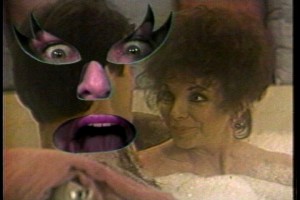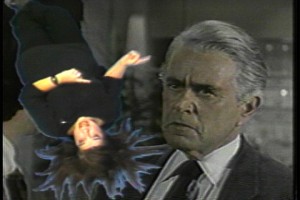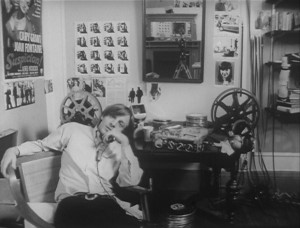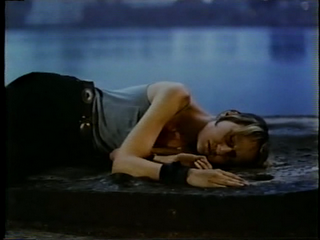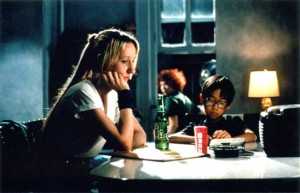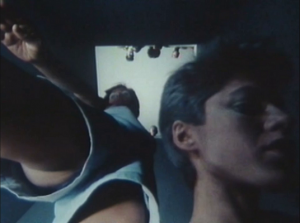From Sight and Sound (Spring 1987). –- J.R.
The Rotterdam Festival is gradually expanding in scope and attendance, while its survival seems to become increasingly polemical and precarious. Now in its 16th edition, the festival continues to honor its director Hubert Bals’ stubborn, utopian precept that, ‘An audience should be found for a film, not a film for an audience.’
Thus, while Libération critic Serge Daney was lecturing persuasively on the growing impossibility of critics mediating between films and audiences, it was possible to watch a videotape, Joan Does Dynasty, in which New York critic Joan Braderman, with the aid of Manuel De Landa’s computer graphics, does precisely that for the TV series.She appears in front of Dynasty in different sizes, shapes and positions, from diverse angles and with varying degrees of transparency, and delivers an exuberant, madcap critique of the show. Part of a cycle of low-budget, leftist media critiques known as Paper Tiger Television which appears on us public access cable and boasts more than a hundred titles in its catalogue, Braderman’s pungent intellectual stand-up is the likely formal masterpiece of a variable, slapdash series ranging from the unfocused and obvious (Peter Wollen on the U.S. press in general) to the razor-sharp and subtle (Herb Schiller on the New York Times‘ foreign coverage).
Another form of instruction came from the Jim McBride retrospective, charting the checkered career of the one-time New York independent who began in the shadow of the New Wave with David Holzman’s Diary (1967) and eventually entered the Hollywood mainstream with his Breathless remake (1983), followed by the more confident (and more conventional) The Big Easy, a sexy crooked cop story set in New Orleans with only a nodding relation to his early work.
The kicker in the series, however, was The Once and Future King, a recent half-hour Twilight Zone episode that powerfully illuminates the closed circuits of the Hollywood recycling machine and the Reaganite nostalgia which fuels it. An Elvis impersonator of the 80s is magically transported back to Memphis 1954, accidentally kills his idol, and winds up cutting Elvis’ first record himself. He then spends the rest of his guilt-ridden life trying to live up to the legend he has created, retreating into drugs and paranoia as he realizes he can never do the King full justice. A poignant rendering of the process by which Hollywood from Star Wars to Blue Velvet forecloses any autonomous grounds for a present or future, the show is itself eerily framed (as usual) by off-screen commentary from a Rod Serling imitator — further suggesting that the once and future cinema can emerge from its cage only by learning to reoccupy the present.
Sara Driver’s ravishing deadpan comedy Sleepwalk does just that, but at the cost of many unfashionable refusals. This nocturnal Rivettean fantasy about a stolen Chinese manuscript in lower Manhattan shares the same compositional beauty and rigor and the same oddly striking actress (Suzanne Fletcher) as Driver’s featurette You Are Not I, but almost none of the narrative momentum which sharpened the earlier film to a prickly point. Opting for poetry over prose and mood over logic, Sleepwalk fashions a luminous, original and very contemporary night city out of a curious dispersal of spare parts: a vain French woman suddenly losing all her hair, an executive barking on the street, unmanned copying machines assuming a life of their own, vanishing fingers and documents. Insofar as it uses plot almost exclusively as a pretext for producing images, sounds and characters, it seems to have little hope of U.S. distribution, despite a Georges Sadoul prize and Mannheim award already under its belt.
Along with Leandro Katz’s The Visit (half an hour of metaphysical paranoia which more or less does for Manhattan what Welles’ The Trial did for Zagreb) and Tian Zhuangzhuang’s The Horse Thief (a beautiful mainland Chinese spectacle of Tibetan death ceremonies and the cold cruelty of landscapes that evokes The Savage Innocents and early Paradjanov), Sleepwalk carries a charge that is above all visceral, largely through the musical modulations of the lighting.
Raul Ruiz’ Mammame turns a Wellesian rhetoric (wide and low angles, deep focus and shadows) on Jean-Claude Gallotta’s spirited dance group, with a camera which seems to change position almost as often as the dancers. Playing with plasticity itself, Mammame contrives to make one even more aware of the floor than one is in an Ozu film — perhaps because it usually remains the only fixed anchor to an endlessly mutable overhead space. Brilliantly achieving the maximum out of a minimal assignment, Mammame gets by without need of a single subtitle; if there is any justice in the world beyond Rotterdam, audiences should be found for this film in diverse corners across the map.
JONATHAN ROSENBAUM

